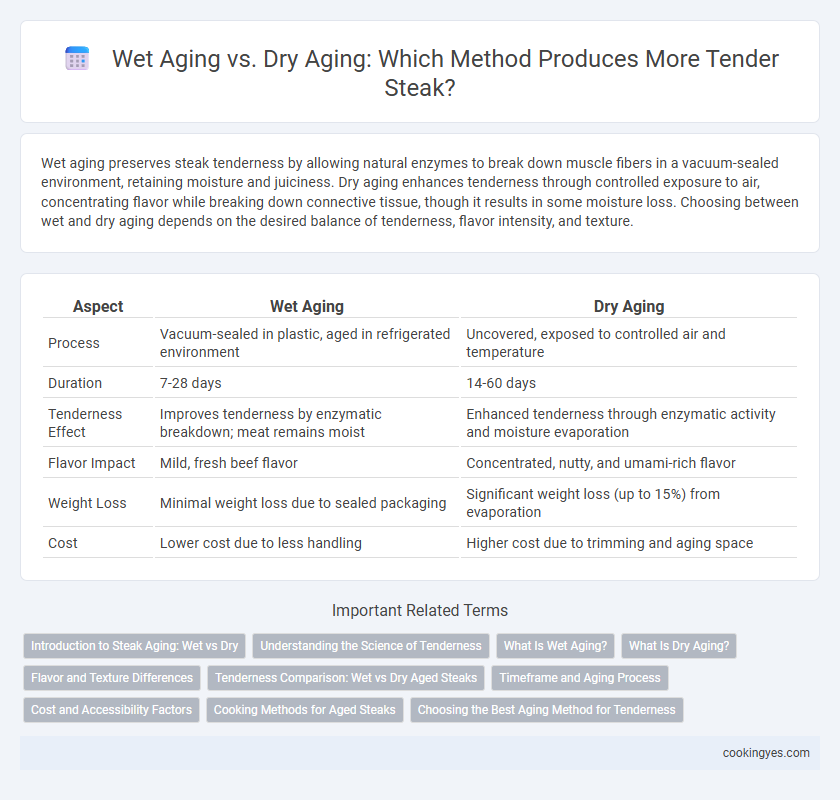Wet aging preserves steak tenderness by allowing natural enzymes to break down muscle fibers in a vacuum-sealed environment, retaining moisture and juiciness. Dry aging enhances tenderness through controlled exposure to air, concentrating flavor while breaking down connective tissue, though it results in some moisture loss. Choosing between wet and dry aging depends on the desired balance of tenderness, flavor intensity, and texture.
Table of Comparison
| Aspect | Wet Aging | Dry Aging |
|---|---|---|
| Process | Vacuum-sealed in plastic, aged in refrigerated environment | Uncovered, exposed to controlled air and temperature |
| Duration | 7-28 days | 14-60 days |
| Tenderness Effect | Improves tenderness by enzymatic breakdown; meat remains moist | Enhanced tenderness through enzymatic activity and moisture evaporation |
| Flavor Impact | Mild, fresh beef flavor | Concentrated, nutty, and umami-rich flavor |
| Weight Loss | Minimal weight loss due to sealed packaging | Significant weight loss (up to 15%) from evaporation |
| Cost | Lower cost due to less handling | Higher cost due to trimming and aging space |
Introduction to Steak Aging: Wet vs Dry
Wet aging involves vacuum-sealing beef in plastic to retain moisture and promote enzymatic breakdown, resulting in a tender, juicy steak with a slightly metallic flavor. Dry aging exposes beef to controlled temperature and humidity, concentrating flavor while breaking down connective tissue, producing a more intense, nutty taste and firmer texture. Both methods enhance tenderness through enzymatic activity but differ in flavor profiles and moisture retention.
Understanding the Science of Tenderness
Wet aging retains moisture by vacuum-sealing beef, allowing enzymatic breakdown of muscle fibers to enhance tenderness within a shorter period, typically 7 to 21 days. Dry aging exposes beef to controlled temperature and humidity, promoting enzyme activity and natural enzymatic breakdown while concentrating flavor through moisture evaporation over 14 to 60 days. Protein degradation and collagen solubilization during both processes improve tenderness, but dry aging develops a more complex flavor profile due to oxidative and enzymatic reactions on the meat's surface.
What Is Wet Aging?
Wet aging is a beef preservation method where cuts of steak are vacuum-sealed in plastic and refrigerated for several days to weeks, allowing natural enzymes to break down muscle fibers and enhance tenderness. This process retains moisture within the meat, resulting in a juicier texture compared to dry aging. Wet aging is typically faster and less expensive than dry aging, making it a popular choice for producing tender steaks in commercial settings.
What Is Dry Aging?
Dry aging is a process where whole beef primal cuts are stored in a controlled, refrigerated environment with precise temperature, humidity, and airflow for several weeks, allowing natural enzymes to break down muscle fibers and enhance tenderness. This method also concentrates flavor by reducing moisture content, resulting in a more intense, nutty taste compared to wet aging, which involves vacuum-sealing meat. Dry-aged steak typically exhibits a firmer texture and richer flavor profile, making it a preferred choice for premium cuts where tenderness and taste are paramount.
Flavor and Texture Differences
Wet aging preserves the steak's natural juices, resulting in a more tender texture with a mild, metallic flavor, while dry aging enhances the beef's flavor by concentrating umami and nutty notes through controlled moisture evaporation. Dry-aged steaks develop a firmer texture and a richer, more complex taste profile, often described as earthy or buttery, due to enzymatic breakdown and oxidation processes. The choice between wet and dry aging impacts both flavor intensity and tenderness, with wet aging favoring juiciness and soft texture, and dry aging delivering depth of flavor and a chewier bite.
Tenderness Comparison: Wet vs Dry Aged Steaks
Dry aged steaks develop enhanced tenderness through natural enzymatic breakdown combined with moisture evaporation, concentrating flavors and softening muscle fibers. Wet aged steaks, sealed in vacuum packaging, retain moisture leading to slightly less tender results but maintain juiciness. Studies show dry aging typically yields a more tender texture compared to wet aging due to prolonged enzymatic activity and reduced water content.
Timeframe and Aging Process
Wet aging typically involves vacuum-sealing beef and storing it at controlled refrigeration temperatures for 7 to 28 days, allowing natural enzymes to break down muscle fibers and enhance tenderness while retaining moisture. Dry aging exposes beef to air in a temperature- and humidity-controlled environment for 14 to 60 days or longer, concentrating flavor and tenderizing the meat through gradual moisture evaporation and enzymatic activity. The dry aging process requires more time and space but results in a more intense flavor profile, whereas wet aging is faster and retains juiciness.
Cost and Accessibility Factors
Wet aging offers a cost-effective and widely accessible method for enhancing steak tenderness by aging meat in vacuum-sealed bags, reducing moisture loss and financial overhead. Dry aging involves higher costs due to specialized climate-controlled environments and weight loss from evaporation, making it less accessible to average consumers. Restaurants and butchers often choose wet aging to balance tenderness with affordability and convenience.
Cooking Methods for Aged Steaks
Wet aging preserves moisture in the steak, making it ideal for quicker cooking methods like grilling or pan-searing to maintain juiciness and tenderness. Dry aging enhances flavor and tenderizes the meat by allowing natural enzymes to break down muscle fibers, best suited for slow roasting or sous vide techniques to evenly cook and retain texture. Choosing the right cooking method for aged steaks maximizes tenderness by complementing the aging process's effects on the meat's structure and moisture content.
Choosing the Best Aging Method for Tenderness
Wet aging locks moisture by vacuum-sealing the steak, resulting in a juicier texture but with slightly less concentrated flavor. Dry aging improves tenderness by breaking down connective tissue through controlled exposure to air, enhancing both flavor intensity and texture. For optimal tenderness, dry aging is preferred when seeking richer flavor and more pronounced tenderness, while wet aging is suitable for maintaining juiciness with a shorter aging time.
Wet aging vs Dry aging for tenderness Infographic

 cookingyes.com
cookingyes.com